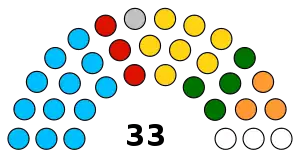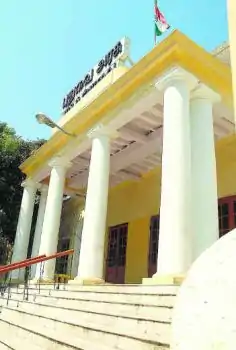Puducherry Legislative Assembly
The Puducherry Legislative Assembly is the unicameral legislature of the Indian union territory (UT) of Puducherry, which comprises four districts: Puducherry, Karaikal, Mahé and Yanam. The legislative assembly has 33 seats, of which 5 are reserved for candidates from scheduled castes and 3 members are nominated by the Government of India. 30 out of 33 Members are elected directly by the people on the basis of universal adult franchise.
Puducherry Legislative Assembly Assemblée législative de puducherry | |
|---|---|
| 14th Assembly of Puducherry | |
 | |
| Type | |
| Type | |
Term limits | 5 years |
| History | |
| Founded | July 1, 1963 |
| Preceded by | Pondicherry Representative Assembly |
| Leadership | |
Deputy Speaker | M. N. R. Balan, INC |
Leader of the House (Chief Minister) | |
Leader of the Opposition | |
Deputy Leader of the Opposition [2] | |
| Structure | |
| Seats | 33 (30 Elected + 3 Nominated) |
 | |
Political groups | Government (16)
Opposition (14) Vacant (3)
|
| Elections | |
| First-past-the-post | |
Last election | 16 May 2016 |
Next election | May 2021 |
| Meeting place | |
 | |
| Puducherry Legislative Assembly | |
Geographically, the area under the Puducherry UT consists of three disjointed regions, with Puducherry and Karaikal districts surrounded by districts of Tamil Nadu, Yanam district an enclave of East Godavari district of Andhra Pradesh, and Mahé district bordered by districts of Kerala. The four districts were ruled by French before they were integrated into India in 1962. For ease of administration, during French rule, the area under these four districts was divided into 39 assembly constituencies. After becoming a UT of India, Puducherry was divided into 30 assembly constituencies, which were restructured in 2005 by the Delimitation Commission of India.
Assembly during French rule
In 1946, French India (Inde française) became Overseas territory (Territoire d'outre-mer) of France. Then a Representative Assembly (Assemblée représentative) was created. Thus, in 1946, on October 25, the representative assembly of 44 members has replaced the general council (conseil général).[3] The Representative Assembly had 44 seats until merger of Chandernagore in 1951. Later, it reduced to 39 seats.
Merger and formation of Union Territory
French Government transferred the four enclaves to the Indian Union under a de facto treaty on 1 November 1954. Later the territory was merged with India on 16 August 1962.
In 1963 on 10 May, as the people aspired for a popular Government, the Indian Parliament enacted the Government of Union Territories Act, 1963 that came into force on 1 July 1963, and the pattern of Government prevailing in the rest of the country was introduced in this territory also, but subject to certain limitations.[4] Under Article 239 of the Indian Constitution, the President of India appoints an Administratoras LG with such designation as he may specify to head the administration of the territory. The President also appoints the Chief Minister. The President on the advice of the Chief Minister appoints the other Ministers.
The Union Territories Act, 1963 has limited the number of elected members of assembly to 30 and also allowed a provision to central government to appoint not more than 3 nominated MLAs. Also, the same act has ensure that seats shall be reserved for the Scheduled Castes in the Legislative Assembly of the Union territory.
The Representative Assembly was converted into the Legislative Assembly of Pondicherry on 1 July 1963 as per Section 54(3) of The Union Territories Act, 1963[4] and its members were deemed to have been elected to the Assembly.[5]:966 Thus, the First Legislative Assembly has been formed without any election. The elections for the Puducherry Vidhan Sabha held since 1964.
Name
Puducherry has 5 official languages, namely, French,[note 1] Tamil; Telugu (in Yanam), Malayalam (in Mahe) and English.[6] In each of these languages, the Legislative Assembly is referred as below
Governance
The Centre is represented by the Lt Governor, who resides at the Raj Niwas, Rangapillai Street, the former palace of the French Governor General of Puducherry. The Central government is more directly involved in the financial well-being of the territory, as against the states where financial administration, given a budgeted central grant is the responsibility to the state governments. Consequently, Puducherry has at various times, enjoyed lower taxes, especially in the indirect category.
Constituencies
The structure of the Puducherry Legislature is unicameral. The Legislative Assembly consists of 33 members. The people on the basis of adult franchise directly elect all the members.
In terms of the provisions of the Government of Union Territories Act, 1963 the normal tenure of the Assembly is five years, unless sooner dissolved. There are 16 Committees in the Assembly.
Parliamentary and assembly constituencies of Puducherry were redesigned by Delimitation Commission of India based on data obtained in 2001 census of India.[7] On 4 January 2008, the Cabinet Committee on Political Affairs (CCPA) decided to implement the order from the Delimitation Commission.[8] In addition, three members can be nominated to the assembly by the central government.[9]
After 1963 Delimitation
As per The Union Territories Act, 1963, thirty members would be elected through direct suffrage.[10][11] Before the Elections to constitute the First Pondicherry Legislative Assembly were held in August 1964, the constituencies were delimited by the Delimitation Commission (as per Delimitation Commission Act, 1962) and the entire territory was divided into 30 single-member constituencies-21 for Pondicherry region, 6 for Karaikal region, 2 for Mahe region and 1 for Yanam region. Out of these 5 seats were reserved for Scheduled Castes,[11] four in Pondicherry region and one in Karaikal region.[5]:965
Before delimitation of 2008
The Puducherry Legislative Assembly has 30 constituencies. Out of them 21 constituencies belong to Puducherry, Karaikal has 6 in number, Mahé has 2 in number and Yanam has a single constituency.
Puducherry was divided among these 21 assembly constituencies: Muthialpet, Cassicade, Raj Bhavan, Bussy, Oupalam, Orleampeth, Nellithope, Modeliarpeth, Ariankuppam, Embalom (SC), Nettapakkam, Kuruvinatham, Bahour (SC), Thirubuvanai (SC), Mannadipeth, Ossudu (SC), Villenour, Ozhukarai, Thattanchavady, Reddiarpalayam and Lawspet.
Area under Karaikal district was divided among the following 6 assembly constituencies: Cotchery, Karaikal, Karaikal South, Neravy-Grand Alde, Tirunallar and Neduncadu (SC).
Assembly constituencies of Mahé and Palloor were from Mahé district. The Yanam district formed a single assembly constituency, i.e. Yanam.
After delimitation of 2008
Post delimitation, the Puducherry parliamentary constituencies is divided among 30 assembly constituencies, as before. Now, Yanam and Mahé districts form a single constituency each, viz Yanam and Mahé, respectively.[7] The area under Karaikal district forms 5 assembly constituencies, viz Nedungadu, Thirunallar, Karaikal North, Karaikal South and Neravy T R Pattinam.[7] The area under the Puducherry district forms 23 assembly constituencies, viz Mannadipet, Thirubuvanai, Ossudu, Mangalam, Villianur, Ozhukarai, Kadirkamam, Indira Nagar, Thattanchavady, Kamaraj Nagar, Lawspet, Kalapet, Muthialpet, Raj Bhavan, Oupalam, Orleampeth, Nellithope, Mudaliarpet, Ariankuppam, Manavely, Embalam, Nettapakkam and Bahour.[7]
The constituencies of Thirubuvanai, Ossudu, Embalam, Nettapakkam and Nedungadu are reserved for candidates from SC.[7]
Current MLAs
See also
- List of constituencies of Puducherry Legislative Assembly
- List of Chief Ministers of Puducherry
- List of lieutenant governors of Puducherry
- List of speakers of the Puducherry Legislative Assembly
- Puducherry (Lok Sabha constituency)
- Puducherry Municipal Council
- Yanam Municipal Council
Notes
- Article XXVIII of Treaty de Cession (1956)
References
- "Sivakolundhu set to be elected Pondy Assembly Speaker". Business Standard India. Press Trust of India. 2 June 2019. Retrieved 3 June 2019.
- https://www.thehindu.com/news/cities/puducherry/Rangasamy-appointed-Opposition- leader/article14585046.ece
- "Les établissements français en Inde au XIXe siècle, 1816-1914 (4)". Jacques Weber. FeniXX. 1988.
- "The Government of Union Territories Act, 1963" (PDF). Ministry of Home Affairs, Government of India. Retrieved 8 June 2020.
- "Cabinet Responsibility to Legislature". G.C.Malhotra. Metropolitan Book Co. Pvt. Ltd. 1964. p. 464.
- "Archived copy of The Official Languages Act 1965". Archived from the original on 2 April 2015. Retrieved 12 June 2015.
- "Delimitation of Parliamentary and Assembly Constituencies in the UT of Pondicherry on the basis of 2001 Census" (PDF). Election Commission of India. 30 March 2005. Retrieved 25 January 2013.
- Sunil Gatade (2008). "Delimitation process now gets CCPA nod".
- https://www.deccanherald.com/national/centre-empowered-nominate-3-706779.html
- Grover, Verinder, and Ranjana Arora. Encyclopaedia of India and Her States. Vol. 10. New Delhi [India]: Deep & Deep, 1996. p. 11
- Election Commission of India. STATISTICAL REPORT ON GENERAL ELECTION, 1964 TO THE LEGISLATIVE ASSEMBLY OF PONDICHERRY Archived 27 January 2013 at the Wayback Machine